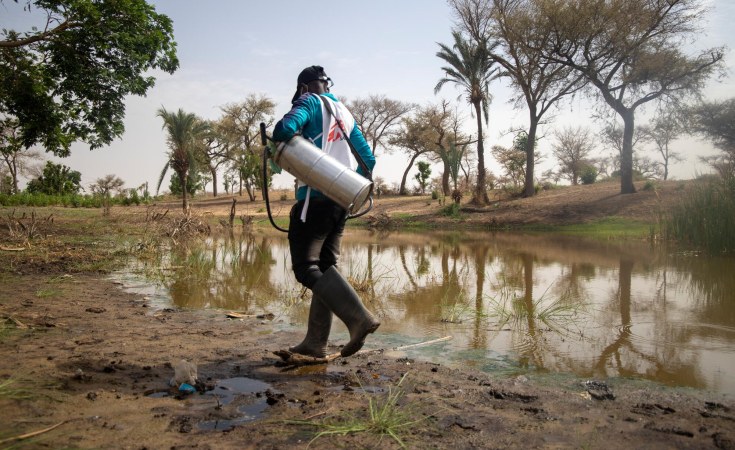New data released today by the World Health Organization (WHO) show that countries around the world largely held the line against further setbacks to malaria prevention, testing and treatment services in 2021.
According to this year's World malaria report, there were an estimated 619 000 malaria deaths globally in 2021 compared to 625 000 in the first year of the pandemic. In 2019, before the pandemic struck, the number of deaths stood at 568 000.
Malaria cases continued to rise between 2020 and 2021, but at a slower rate than in the period 2019 to 2020. The global tally of malaria cases reached 247 million in 2021, compared to 245 million in 2020 and 232 million in 2019.
"Following a marked increase in malaria cases and deaths in the first year of the COVID-19 pandemic, malaria-affected countries redoubled their efforts and were able to mitigate the worst impacts of Covid-related disruptions to malaria services," said Dr Tedros Adhanom Ghebreyesus, WHO Director-General.
"We face many challenges, but there are many reasons for hope. By strengthening the response, understanding and mitigating the risks, building resilience and accelerating research, there is every reason to dream of a malaria-free future."
Strong national-level commitment key to success Insecticide treated bednets (ITNs) are the primary vector control tool used in most malaria-endemic countries and, in 2020, countries distributed more ITNs than in any year on record. In 2021, ITN distributions were strong overall and at similar levels to pre-pandemic years: of the 171 million ITNs planned for distribution, 128 million (75%) were distributed.
However, eight countries (Benin, Eritrea, Indonesia, Nigeria, Solomon Islands, Thailand, Uganda and Vanuatu) distributed less than 60% of their ITNs, and seven countries (Botswana, Central African Republic, Chad, Haiti, India, Pakistan and Sierra Leone) did not distribute any ITNs.
Seasonal malaria chemoprevention (SMC) is recommended to prevent the disease among children living in areas with highly seasonal malaria transmission in Africa. In 2021, further expansion of this intervention reached nearly 45 million children per SMC cycle in 15 African countries, a major increase from 33.4 million in 2020 and 22.1 million in 2019.
At the same time, most countries succeeded in maintaining malaria testing and treatment during the pandemic. Despite supply chain and logistical challenges during the pandemic, malaria-endemic countries distributed a record number of rapid diagnostic tests (RDTs) to health facilities in 2020. In 2021, countries distributed 223 million RDTs, a similar level reported before the pandemic.
Artemisinin-based combination therapies (ACTs) are the most effective treatment for P. falciparum malaria. Malaria-endemic countries delivered an estimated 242 million ACTs worldwide in 2021 compared to 239 million ACTs in 2019.
A convergence of threats undermining efforts
Despite successes, our efforts face many challenges, particularly in the African Region, which shouldered about 95% of cases and 96% of deaths globally in 2021.
Disruptions during the pandemic and converging humanitarian crises, health system challenges, restricted funding, rising biological threats and a decline in the effectiveness of core disease-cutting tools threaten the global response to malaria.
"Despite progress, the African region continues to be hardest hit by this deadly disease," said Dr Matshidiso Moeti, WHO Regional Director for Africa. "New tools—and the funding to deploy these—are urgently needed to help us defeat malaria."
Total funding for malaria in 2021 was US$ 3.5 billion, an increase from the two previous years but well below the estimated US$ 7.3 billion required globally to stay on track to defeat malaria.
At the same time, a decline in the effectiveness of core malaria control tools, most crucially ITNs, is impeding further progress against malaria. Threats to this key prevention tool include insecticide resistance; insufficient access; loss of ITNs due to the stresses of day-to-day use outpacing replacement; and changing behaviour of mosquitoes, which appear to be biting early before people go to bed, and resting outdoors, thereby evading exposure to insecticides.
Other risks are also rising, including parasite mutations affecting the performance of rapid diagnostic tests; growing parasite resistance to the drugs used to treat malaria; and the invasion in Africa of an urban-adapted mosquito that is resistant to many of the insecticides used today.
Key opportunities to accelerate progress
WHO recently launched 2 strategies to support countries in the African continent as they work to build a more resilient response to malaria: a strategy to curb antimalarial drug resistance and an initiative to stop the spread of the Anopheles stephensi malaria vector. Additionally, a new global framework to respond to malaria in urban areas, developed jointly by WHO and UN-Habitat, provides guidance for city leaders and malaria stakeholders.
Meanwhile, a robust research and development pipeline is set to bring a new generation of malaria control tools that could help accelerate progress towards global targets.
Key opportunities include long-lasting bednets with new insecticide combinations and other innovations in vector control, including targeted baits that attract mosquitoes, spatial repellents and genetic engineering of mosquitoes. New diagnostic tests are also under development, as are next-generation life-saving medicines to respond to antimalarial drug resistance.
From late 2023 onwards, millions of children living in areas of highest risk of illness and death from malaria are also expected to benefit from the life-saving impact of the world's first malaria vaccine, RTS,S. Other malaria vaccines are in the product development pipeline.
According to the report, these opportunities cannot be fully exploited without intensified efforts to ensure that nobody is left behind. Malaria-endemic countries should continue to strengthen their health systems, using a primary health care approach, to ensure access to quality services and interventions for all in need.
Note to editors
WHO's work on malaria is guided by the Global technical strategy for malaria 2016-2030 (GTS), approved by the World Health Assembly in May 2015, and updated in 2021 to reflect the lessons learned in the global malaria response during the period 2016 to 2020.


